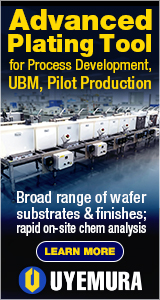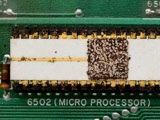|

|
|
| Ask the Experts | ||||||||||
|
||||||||||
|
April 3, 2025 - Updated March 6, 2018 - Originally Posted Contamination From Anti-static Foam
Due to the rarity and value of this board, I want to preserve it and ensure it will still be operational. It has been suggested that a 90%+ isopropyl alcohol soak for the entire board followed by bruising with a soft toothbrush is recommended. Do you have any other thoughts on how best to tackle this problem? J.G. |
||||||||||
| Expert Panel Responses | ||||||||||
|
I would suggest to go with 99% isopropyl. It's more expensive but works well. Use fresh isopropyl or denatured ethanol and let the board dry in a warm oven to drive off any alcohol that might be stuck under parts. Should work fine. Take care of components which might get damaged during full dip on this board. Use anti-static brush.
PCBA Industrialization Schneider Electric Experienced engineering leader with 25+ years in electrical & electronic components qualification, reliability testing, and global lab operations. Expertise includes batteries, transformers, cables, connectors, PCB/PCBA processes, and active & passive electronic components, along with supplier capability development. Recognized for driving innovation, standardization, and technical excellence across global teams.
Many of the pink poly materials from that time era were doped with various amine complexes to provide the static protection. I suspect that is the case here. Your solution may work, but I would use 50/50 isopropanol / water. If that does not work, try 10% methanol and 90% deionized water.
Principal Materials and Process Engineer Collins Aerospace Doug Pauls has a bachelors in Chemistry & Physics, Carthage College, BSEE, Univ of Wisc Madison. He has 9 years working experience for US Navy - Materials Lab, Naval Avionics Center Indianapolis. 8 years Technical Director, Contamination Studies Laboratories. 11 years Rockwell Collins Advanced Operations Engineering.
Yes, 70% or higher IPA with mild brushing should do the trick. If not you can get some CPU thermal compound remover followed by IPA. Be sure it is dried fully and then plastic wrap it.
President and Founder Fein-Line Associates Mr. Feinberg is a 52 year industry veteran and President and founder of Fein-Line Assoc, a consulting group serving the Global Interconnect and EMS industries.
A soak in IPA will only be useful if the material is soluble in a polar solvent which it may not be based on the material used and its age. You would also need to ensure that the parts on the assembly are suitable for immersion in a solution although again based on the age of the parts, this assembly was probably vapor cleaned post soldering. You might want to consider a dry ice vapor cleaning method as a safe and efficient alternative to a soak and brush.
President S T and S Testing and Analysis Gerald O'Brien is Chairman of ANSI J-STD 003, and Co Chairman of IPC 4-14 Surface Finish Plating Committee. He is a key member of ANSI J-STD 002 and 311 G Committees Expert in Surface finish, Solderability issues and Failure analysis in the PWA, PWB and component fields.
Without knowing the types of materials on this board, it sounds like the advice you have been given is good. I would only suggest several immersions with fresh 90% alcohol. In this photo I cannot see a conformal coating. Your chief concern is probably ionic contamination, which could short out the runs or leads on the chips. So, prior to firing up the board, make a careful inspection of the component leads to ensure there is not bridging of some type of foreign substance that could short it out.
President Chem Logic Rick Perkins is a chemical engineer with more than 33 years of Materials & Processes experience. He has worked with Honeywell Aerospace in high-reliability manufacturing, as well as with several oil-field manufacturing companies. He also has a good understanding of environmental, health, and safety regulations.
Since you mention this is a high value PCBA and you want it to remain operational, your best option is to have the residues analyzed to determine the best solvent without affecting your board.
Senior Manufacturing Engineer Northrop Grumman Edithel is a chemical engineer with 20 year experience in manufacturing & process development for electronic contract manufacturers in US as well as some major OEM's. Involved in SMT, Reflow, Wave and other assembly operations entailing conformal coating and robotics.
I would suggest DI water Steam with hand controlled wand. The foam has decomposed and the grounded steam line will allow both mechanical and thermal removal of the foam particles. If you are interested we can talk about how we can do this for you.
President/Senior Technical Consultant Foresite Mr. Munson, President and Founder of Foresite, has extensive electronics industry experience applying Ion Chromatography analytical techniques to a wide spectrum of manufacturing applications.
Your question involves two steps:
Step two, once we know if organic or inorganic in nature we can then select chemical solvent (e.g., Alcohol, Surfactant, Saponifier, terpene, etc.), plasma ( e.g., Argon, Oxygen, etc.) and/or subsequent mechanical cleaning ( e.g., burnish, wipe, brush, etc.). You don't state what the end application the assembly operates in ( e.g., IPC Class 1, 2, 3) for subsequent Ion Chromatography (IC) limits for verifying truly clean via Anions, Cations, and WOAs remaining to eliminate metal migration due to surface Ionics left behind.
Fellow Raytheon Mark has over 35 years of experience in electronics fabrication, quality, and reliability while working for Raytheon RMD, IEC Electronics, GE, Motorola, ORS, etc. He has most recently taken the role as a Fellow at Raytheon in Tucson, AZ; prior to that, he established IEC Electronics Analysis and Testing Laboratories (IATL), LLC in Albuquerque, NM, for electronics and material analysis testing in the military, medical, and industrial industries. His expertise includes PCB, PCBA, components, and analytical and electrical analysis techniques.
Before soaking the whole board I would look to try any cleaning solvent you try to se on a small area that is not as important as ICs etc. Either use a cotton bud soaked in the solvent or a lint free tissue soaked in the solvent and a brush. With the tissue method have the tissue between the brush and the residue, this will stop the brush soaking up the residue and spreading it to other areas of the board, unless you have lots of brushes and can throw them away as soon as the brush is contaminated. The IPA solution is probably cheapest, but there are other cleaning solutions available from hobby stores and people like RS or tool station. As the board is old the residues are certainly natural rosin from the fluxes used combined with whatever else they have collected these should easily clean off.
Global Product Champion Henkel Electronics Richard Boyle is a Global Product Champion at Henkel Electronics. He has over 25 years experience in the electronics assembly industry and is responsible for the global technical service of all of Henkel's solder materials.
I agree with Dr. Pauls recommendations, assuming it is not a coated CCA. However, I would follow that with an immediate deionized water wash using an appropriate saponifier. I say immediate because allowing the 50/50 mix any time to evaporate may leave behind the suspended sticky particles, simply in different locations. An immediate saponified wash, thorough blow-off will remove all suspended contaminants. At that point I would inspect at 20X magnification and if the CCA appears to be very clean, follow with a bake of 105 deg. C for no more than 20 minutes to produce a very clean but also a very dry CCA, free of anything left behind by the cleaning process. If the CCA is coated, all of the experts proposed cleaning methods may not apply, except possibly the steam treatment by Foresite. I know that has been used on coated CCAs successfully. That is also a good option if not coated.
Advanced Engineer/Scientist General Dynamics Richard D. Stadem is an advanced engineer/scientist for General Dynamics and is also a consulting engineer for other companies. He has 38 years of engineering experience having worked for Honeywell, ADC, Pemstar (now Benchmark), Analog Technologies, and General Dynamics.
|
||||||||||
| Submit A Comment | ||||||||||
|
Comments are reviewed prior to posting. You must include your full name to have your comments posted. We will not post your email address. |
|
Free Newsletter Subscription
Circuitnet is built for professionals who bear the responsibility of looking ahead, imagining the future, and preparing for it. Insert Your Email Address |
|

|











